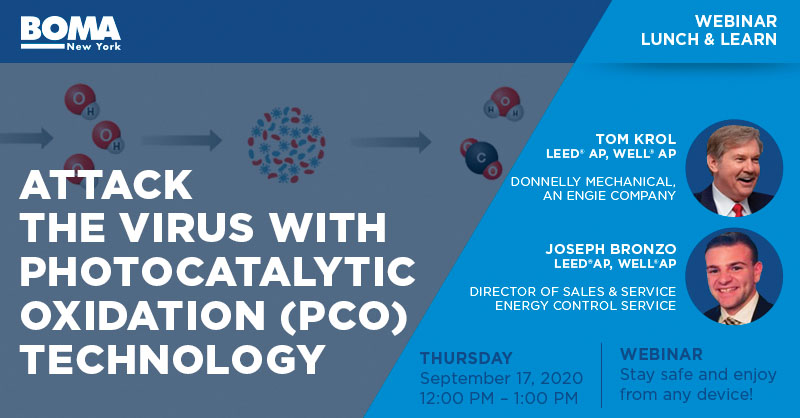BOMA New York hosts Sept. Lunch ‘N Learn webinar

Hani Salama, P.E., LEED AP
Capital Properties
New York, NY If you have not learned about the indoor air quality technology known as photocatalytic oxidation (PCO)–it’s used on the International Space Station–now would be a very good time to start.
BOMA New York’s Deb Deluca emceed the BOMA NY hosted September edition of its monthly Lunch’n Learn webinar. Co-presenters, Tom Krol, vice president for business development of Donnelly Mechanical HVAC Energy Services, and Joseph Bronzo, director of sales & service for ECS Energy Control Service, delivered a vital and informative presentation on PCO.
The technology could have an evolutionary impact on the way that building owners and managers seek solutions for improved indoor air quality at a time of the COVID-19 pandemic.
As Krol explains, PCO is a proven, scientific method for air and surface sanitizing. Rather than relying only on filtration (which is also encouraged), PCO actually changes the chemical, molecular nature of the moisture in the air that passes through the unit.
The ActivTek Air Scrubber uses patented “AtivePure” technology. In addition to being deployed on the International Space Station, it has been used in hospital operating rooms for many years, super-cleaning air before starting surgical procedures and immediately thereafter.
Here’s how PCO works: A cartridge containing a UV light source is positioned within a titanium dioxide (TiO2) catalytic matrix, or honeycomb. Air that passes through the cartridge is chemically changed into powerful, yet friendly oxides known as “OH” radicals, which attack VOCs, bacteria, viruses, fungi, and mold. Krol calls these oxidizers “purification warriors against microscopic contaminants.”
PCO’s reliable, “no moving parts” hardware can be inserted in ductwork, 2x2 drop ceilings, gypsum board ceilings, and raised floor HVAC systems.
For example, as Krol states, “Every night when the cleaning company comes in and wipes down surfaces, many cleaning solutions contain VOCs (volatile organic compounds).” This can be effective germ-fighting, but it also introduces a contaminant into the air. He adds, “PCO converts air within ductwork into ‘little Pac-Men’ that attack the contaminants left behind.”
ActivePure devices are manufactured in all sizes from mini-units that can be plugged directly into a desk-side electrical wall socket, to much larger units that can meet virtually unlimited requirements of scale, from a 250 s/f office to multiple 10,000 s/f ducted areas. The equipment is completely passive and works in real time, 24/7 or whenever the HVAC is on. The units require 110 or 220 volt AC current and very little amperage – basically just to illuminate the UV light source (13 to 50 watts maximum, depending on the unit). It is designed to work full-time, with cartridge changes just once a year.
Manufacturers claim an 80% reduction of contaminants in just two hours of use, or 99% reduction in 24 hours, provided that the hardware is matched to the needs of the interior space volume. The results are readily noticeable improvements in indoor air quality (IAQ). Air is cleaned, deodorized, protected and purified.
Regarding PCO’s effectiveness against the COVID-19 coronavirus, Krol states that samples of the virus are strictly controlled. No one has yet had a chance to test the technology against the virus, but the technology is highly effective against other tested MS2 virus strains.
In the presentation, Bronzo addressed the IAQ controls side of the technology, also with encouraging news. His company offers detectors that can monitor, in real time, levels of air temperature, humidity, CO2, VOCs and particulates in the PM 2.5 and PM 10 ranges. He says, “Anything less than 800 parts per million of CO2 in offices and under 2000 parts per million of CO2 in large open spaces are acceptable.” He then demonstrated the IAQ dashboard installed in the Donnelly offices. Readings were displayed and updated in real time, including VOC levels from cleaning solution chemicals.
Only half in jest, Krol added, “What happens when CO2 goes up? You get sleepy!” That said, a strong case could be made for increasing employee productivity by improving IAQ. “The air even smells cleaner,” Krol adds.
Bronzo explained that IAQ data can be stored and archived, in addition to being displayed to designated on-site employees and visitors. The data can be used not only to diagnose IAQ problems and hot spots, but to resolve IAQ complaints from tenants. He says, “It used to be about being too hot in the summer and too cold in the winter. Now it’s about air quality and health issues in addition to that.”
In conclusion, both presenters predicted that, post-COVID-19, air quality standards will be hard written into leasing agreements. Forewarned is forearmed.
Habitat, Duvernay + Brooks and Buffalo Municipal Housing close on 254-unit first phase redev. of Marine Drive Apts.


Strategies for turning around COVID-distressed properties - by Carmelo Milio








.gif)

.gif)
.jpg)
.gif)